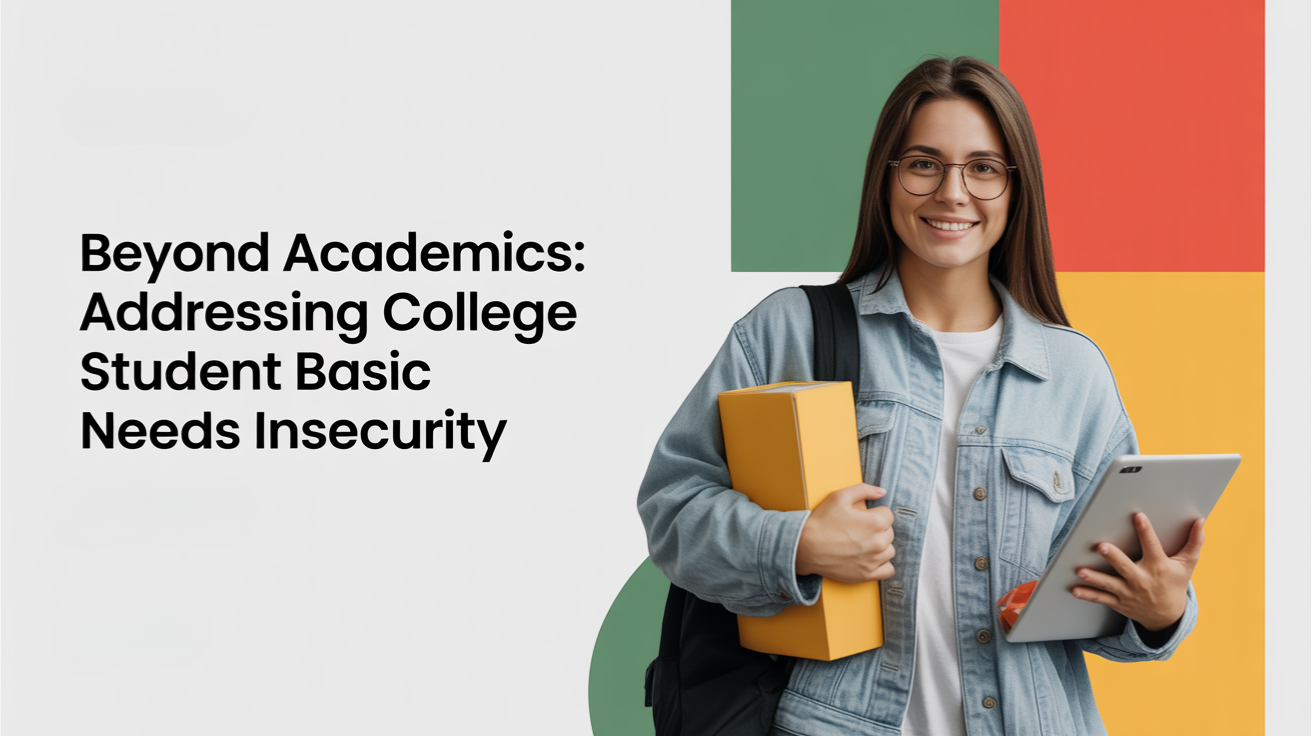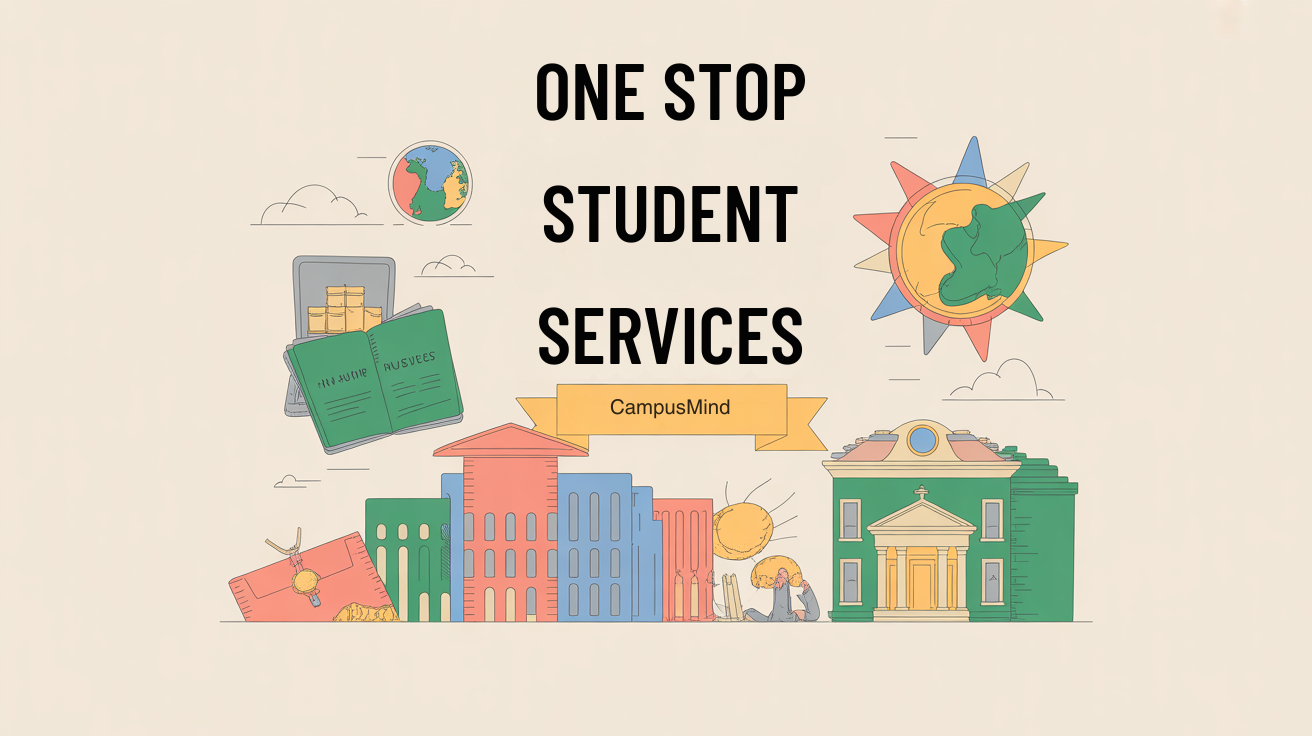Nearly 60% of college students experience basic needs insecurity, lacking consistent access to food, housing, or other essential resources. This widespread challenge directly impacts student retention, with 79% of students who stop out citing basic needs insecurity as a primary reason. Institutions can address this through food pantries, emergency grants, case management, and partnerships with community organizations.
The Hidden Crisis Threatening Student Success
When students arrive on campus, administrators focus on academic preparation, class schedules, and career readiness. But there's a barrier affecting more than half of today's college students that has nothing to do with textbooks or test scores. Nearly three in five college students experience at least one form of basic needs insecurity related to food or housing, creating obstacles that derail academic progress before students can demonstrate their full potential.
The impact goes far beyond empty stomachs or temporary housing concerns. Among students who stopped out of college or were considering doing so, 79% cited basic needs insecurity or financial challenges as their reasoning. For campus leaders focused on retention metrics and graduation rates, addressing college student basic needs insecurity isn't a social justice initiative—it's an enrollment management imperative.
Understanding the Scope of College Student Basic Needs Insecurity

College student basic needs insecurity encompasses more than food and shelter. It includes lack of access to adequate housing, food, health care and mental health services, child care, internet connectivity, and transportation. When students struggle with these fundamental resources, their ability to focus on coursework diminishes dramatically.
The numbers paint a stark picture. Among college students surveyed, 41% reported experiencing food insecurity in the past 30 days, 48% indicated housing insecurity, and 14% experienced homelessness in the previous year. When the definition expands to include mental health care, childcare, transportation, and technology access, 73% of students report experiencing at least one form of basic needs insecurity.
Certain student populations face disproportionate challenges. Among Black and Indigenous respondents, almost 75% reported at least one food or housing insecurity, compared with 55% of White respondents. Students with disabilities, Pell Grant recipients, part-time students, former foster youth, and those with incarceration history all experience higher rates of basic needs insecurity.
Research demonstrates clear connections between basic needs security and student success. Students experiencing all three forms of insecurity—food, financial, and housing—were more likely to have anxiety and depression, fair or poor health, and lower GPA compared to fully secure students.
Research demonstrates clear connections between basic needs security and student success. Students experiencing all three forms of insecurity—food, financial, and housing—were more likely to have anxiety and depression, fair or poor health, and lower GPA compared to fully secure students.
The academic consequences extend beyond grades. Students who dropped out were overwhelmingly more likely to have experienced severe food insecurity and housing insecurity. These aren't students failing due to lack of ability or motivation—they're leaving because they can't afford to stay.
Perhaps most concerning is the awareness gap. Almost two in three students reported that they lacked awareness about available supports, and 51% of students who experienced at least one type of basic needs insecurity did not receive any public benefits. Students are struggling in silence, often unaware that help exists on their own campuses.
Effective Programs That Make a Difference
Leading institutions have developed comprehensive approaches to address college student basic needs insecurity through multiple interventions.
Food Pantries and Distribution Programs
Over 350 on-campus food pantries have been established in the last decade, providing students with access to non-perishable and perishable food. Successful programs go beyond static pantry locations. Mobile food pantries use trucks to deliver food in temporary distribution zones on campus at specified times, making resources more accessible to students with transportation challenges or limited schedules.
Some institutions have formed creative partnerships. Colleges partner with local businesses like Starbucks to use donated leftover pastries to offer pop-up snack carts to students, reducing food waste while addressing student hunger.
Emergency Financial Assistance
Emergency grants provide critical stopgap funding for students facing unexpected expenses. These grants typically range from $50 to $300 and help students cover immediate needs for groceries, housing costs, or other essentials. The flexibility of emergency aid allows students to address their most pressing needs without navigating complex bureaucratic processes.
Case Management and Wraparound Services
The most effective interventions combine multiple supports through dedicated case managers. Case managers typically have backgrounds in social work and work directly with students to connect them with both campus and community resources.
Leading community colleges have identified six core features of strong basic needs support: comprehensive supports, dedicated staff and partnerships, broad outreach efforts, streamlined intake and case management, institutional culture that prioritizes basic needs, and data-informed practices.
At a community college in Fort Worth, Texas, researchers evaluated a comprehensive case management program called Stay the Course, which included mentoring and emergency financial assistance, and found that students who received these combined services were significantly more likely to stay in school and graduate.
Partnerships with Community Organizations
External partnerships with community organizations and universities help supplement on-campus resources and allow college staff to make referrals to support not offered directly by the institution. These partnerships extend the reach of campus programs without requiring institutions to build every service from scratch.
Successful partnerships include collaborations with food banks, housing authorities, healthcare providers, and social service agencies. Establishing partnerships with local housing authorities, nonprofits, and private organizations can offer emergency housing assistance to homeless or housing-insecure students.
Connecting Students to Federal Benefits

Many students eligible for federal assistance programs remain unaware or unable to access these resources. Among college students experiencing basic needs insecurity, 51% did not receive any public benefits, and among students facing housing insecurity or homelessness, 88% did not utilize public housing or utility assistance.
The Supplemental Nutrition Assistance Program (SNAP) provides crucial support for food-insecure students, yet eligibility rules remain complex. Students attending an institution of higher education more than half-time are only eligible for SNAP if they meet an exemption, such as working at least 20 hours per week, participating in work-study, caring for dependents, or being enrolled in certain employment and training programs.
According to a Government Accountability Office report, around 67% of potentially eligible college students are not receiving SNAP benefits, with experts citing lack of awareness, stigma, and complex eligibility rules as contributing factors.
Campus administrators can help bridge this gap. California State University hosts campus outreach programs, both in-person and on social media, to raise awareness for SNAP eligibility and offer application assistance for students.
Breaking Down Stigma and Increasing Awareness
Even when resources exist, students may not access them due to stigma or lack of awareness. Among students who reported at least one basic need insecurity, 48% didn't know about relevant support services on their campus.
Campus leaders must communicate frequently and proactively about available resources. What's key with any basic need support system is communicating to students frequently and early about what resources are available to them, and emphasizing that they are free or low cost, which encourages help-seeking behavior and normalizes students receiving support from the college.
When asked about their willingness to use services, 64% of respondents said they would be somewhat or very likely to attend in-person counseling if they were struggling with their mental health, and 65% said a lack of awareness about resources prevented them from receiving more support for their basic needs.
The Policy and Funding Landscape
The current policy environment presents both challenges and opportunities. The Hope Center calls for comprehensive policy reforms, including removing barriers to SNAP for college students and eliminating restrictions that prevent students from accessing federal housing supports, noting that current federal policies often exclude students based on outdated assumptions about family financial support.
Federal emergency aid programs have proven effective. During the pandemic, Higher Education Emergency Relief Fund (HEERF) grants provided crucial support. Among recipients of HEERF emergency aid, 61% reported using funds to purchase food and 50% used funds for housing.
State-level initiatives also show promise. Minnesota's Hunger Free Campus grant program provides up to $500,000 to institutions for equipment necessary to operate on-campus food pantries, with additional sustaining grants available.
Integrating Basic Needs Support into Early Alert Systems
Rather than treating basic needs as a separate initiative, leading institutions integrate these supports into existing integrated student support systems. When faculty submit early alerts about student struggles, case managers can proactively reach out to connect students with food pantries, emergency grants, or community resources.
This integration ensures that basic needs assessment becomes routine rather than reactive. Students don't need to self-identify as food insecure or homeless—advisors and faculty can initiate supportive conversations based on observed patterns like missed classes, declined academic performance, or expressed financial concerns.
Building Institutional Commitment
Sustainable basic needs programs require more than good intentions—they need institutional prioritization. At Trinity Valley Community College, comprehensive advocacy led to the creation of a taskforce called "The Whole Student Approach," a new Associate VP position for Student Advocacy, and increased presidential support for wraparound services.
Federal funding helped some colleges expand their capacity for support, and some state and system initiatives now require dedicated case managers or basic needs navigators. Institutions that view basic needs security as central to their mission—not an optional add-on—create environments where students can thrive.
Moving Forward: A Call to Action for Campus Leaders
Addressing college student basic needs insecurity requires comprehensive, sustained effort across multiple levels of the institution. Campus leaders should audit existing resources, identify gaps, build community partnerships, train faculty and staff to recognize signs of college student basic needs insecurity, and establish clear referral pathways.
The evidence is clear: students cannot focus on academic success when they're worried about their next meal or where they'll sleep tonight. By treating basic needs security as foundational to the educational mission, institutions can dramatically improve retention, graduation rates, and overall student wellbeing.
Ready to take action? Start by surveying your students to understand the scope of basic needs insecurity on your campus, then prioritize the interventions that will have the greatest impact. Every student deserves the opportunity to succeed, and meeting basic needs is where that opportunity begins.
Learn how Campus Mind helps institutions identify and support students facing basic needs challenges through real-time engagement data.
Works Cited
[1] Diverse Education — "College Students Face Widespread Basic Needs Insecurity, New Report Finds." https://www.diverseeducation.com/students/article/15738367/college-students-face-widespread-basic-needs-insecurity-new-report-finds. Published: 2025-02-26. Accessed: 2025-10-18.
[2] Inside Higher Ed — "Majority of California Community College Students Lack Basic Needs." https://www.insidehighered.com/news/student-success/health-wellness/2025/09/29/majority-california-community-college-students-lack. Accessed: 2025-10-18.
[3] ECMC Foundation — "Basic Needs Initiative." https://www.ecmcfoundation.org/what-we-do/initiatives/basic-needs-initiative. Accessed: 2025-10-18.
[4] BMC Public Health — "A cross sectional assessment of basic needs insecurity prevalence and associated factors among college students." https://bmcpublichealth.biomedcentral.com/articles/10.1186/s12889-022-12817-6. Published: 2022-03-02. Accessed: 2025-10-18.
[5] Inside Higher Ed — "Most college students lack sufficient food, housing." https://www.insidehighered.com/news/student-success/health-wellness/2025/02/27/most-college-students-lack-sufficient-food-housing. Published: 2025-02-27. Accessed: 2025-10-18.
[6] University of Hawaii System News — "New survey highlights urgent basic needs insecurities among UH students." https://www.hawaii.edu/news/2025/10/06/new-survey-highlights-urgent-basic-needs-insecurities/. Published: 2025-10-06. Accessed: 2025-10-18.
[7] Inside Higher Ed — "College Programs Support Holistic Student Basic Needs." https://www.insidehighered.com/news/student-success/health-wellness/2025/05/12/college-programs-support-holistic-student-basic. Published: 2025-05-12. Accessed: 2025-10-18.
[8] Inside Higher Ed — "College Students With Kids More Likely to Lack Basic Needs." https://www.insidehighered.com/news/student-success/health-wellness/2025/09/04/college-students-kids-more-likely-lack-basic-needs. Published: 2025-09-04. Accessed: 2025-10-18.
[9] PMC — "Understanding the cumulative burden of basic needs insecurities: associations with health and academic achievement among college students." https://pmc.ncbi.nlm.nih.gov/articles/PMC8754159/. Accessed: 2025-10-18.
[10] The Hope Center — "The Hope Center Student Basic Needs Survey." https://hope.temple.edu/research/hope-center-basic-needs-survey. Accessed: 2025-10-18.
[11] The Hope Center — "2023-2024 Student Basic Needs Survey Report." https://hope.temple.edu/research/hope-center-basic-needs-survey/2023-2024-student-basic-needs-survey-report. Accessed: 2025-10-18.
[12] Higher Ed Dive — "'SEND HELP!': 59% of students face insecurities around needs like food and housing." https://www.highereddive.com/news/send-help-59-of-students-face-insecurities-around-needs-like-food-and/741774/. Published: 2025-03-11. Accessed: 2025-10-18.
[13] The Hope Center — "The Hope Center's 2025 Federal Policy Priorities." https://hope.temple.edu/policy-advocacy/hope-centers-2025-federal-policy-priorities. Accessed: 2025-10-18.
[14] Community Commons — "Innovative Initiatives on College Campuses Addressing Food Insecurity." https://www.communitycommons.org/collections/Innovative-Initiatives-on-College-Campuses-Addressing-Food-Insecurity. Accessed: 2025-10-18.
[15] College of Alameda — "Basic Needs." https://alameda.edu/campus-life/basic-needs/. Accessed: 2025-10-18.
[16] Swipe Out Hunger — "Swipe Out Hunger Awards Over $420,000 in Grants." https://swipehunger.org/swipegrants2023/. Published: 2023-12-21. Accessed: 2025-10-18.
[17] Minnesota Office of Higher Education — "Hunger Free Campus Grants." https://ohe.state.mn.us/mPg.cfm?pageID=2492. Published: 2025-06-10. Accessed: 2025-10-18.
[18] AFMC — "Food Pantries Ease Food Insecurity on College Campuses." https://www.afmc.org/blog/college-food-insecurity. Published: 2025-07-09. Accessed: 2025-10-18.
[19] US Department of Education — "SNAP Benefits for Eligible Students." https://fsapartners.ed.gov/knowledge-center/library/electronic-announcements/2025-01-16/snap-benefits-eligible-students. Accessed: 2025-10-18.
[20] USDA Food and Nutrition Service — "Students." https://www.fns.usda.gov/snap/students. Accessed: 2025-10-18.
[21] US News — "How to Get Food Stamps in College." https://www.usnews.com/education/articles/how-to-get-food-stamps-in-college. Published: 2024-09-09. Accessed: 2025-10-18.
[22] RAND — "The Six Core Features of Student Basic Needs Support in Community Colleges." https://www.rand.org/pubs/research_briefs/RBA3771-3.html. Published: 2025-06-02. Accessed: 2025-10-18.
[23] RAND — "Promising Approaches to Student Basic Needs Support." https://www.rand.org/pubs/research_reports/RRA3771-3.html. Published: 2025-06-02. Accessed: 2025-10-18.
[24] Education Northwest — "Basic Needs." https://educationnorthwest.org/areas-of-work/postsecondary-success/basic-needs. Accessed: 2025-10-18.
[25] The Hope Center — "Partner Spotlight: Trinity Valley Community College." https://hope.temple.edu/partner-spotlight-basic-needs-access-trinity-valley-community-college. Accessed: 2025-10-18.
[26] EAB — "Are you meeting students' basic needs?" https://eab.com/resources/blog/community-college-blog/are-you-meeting-students-basic-needs/. Published: 2024-01-03. Accessed: 2025-10-18.
[27] J-PAL — "The impact of case management on community college persistence and graduation." https://www.povertyactionlab.org/evaluation/impact-case-management-community-college-persistence-and-graduation-united-states. Accessed: 2025-10-18.
Frequently Asked Questions
Q: What percentage of college students experience basic needs insecurity?
A: Nearly 59% of college students experience at least one form of basic needs insecurity related to food or housing. When the definition expands to include mental health care, childcare, transportation, and technology access, this number rises to 73% of students. The problem is particularly acute among Black and Indigenous students, with 75% reporting insecurity compared to 55% of White students.
Q: How does basic needs insecurity affect student retention?
A: Basic needs insecurity directly impacts retention rates, with 79% of students who stop out citing basic needs challenges or financial issues as primary reasons for leaving. Students experiencing food, financial, and housing insecurity simultaneously show higher rates of anxiety, depression, poor health, and lower GPAs compared to secure students. The connection between meeting basic needs and academic persistence is unequivocal.
Q: What are the most effective programs to address student basic needs?
A: Research identifies six core features of effective programs: comprehensive supports including food pantries and emergency grants, dedicated staff with case management backgrounds, broad outreach efforts to raise awareness, streamlined intake processes, institutional culture prioritizing basic needs, and data-informed practices. Community college case management programs combining mentoring and emergency financial assistance have shown significant improvements in persistence and graduation rates.
Q: Can college students qualify for SNAP benefits?
A: Yes, college students enrolled at least half-time can qualify for SNAP if they meet specific exemptions, such as working at least 20 hours per week, participating in work-study programs, caring for dependents, or being enrolled in employment and training programs. However, approximately 67% of potentially eligible college students do not receive SNAP benefits due to lack of awareness, stigma, and complex eligibility rules.
Q: How can colleges increase awareness of basic needs resources?
A: Colleges should communicate frequently and early about available resources, emphasizing that services are free or low-cost. Effective strategies include faculty training to recognize signs of basic needs insecurity, peer-to-peer outreach, integration with early alert systems, partnerships with trusted advisors like faculty and coaches, and proactive case management rather than waiting for students to self-identify. Research shows 65% of students cite lack of awareness as preventing them from accessing support.




